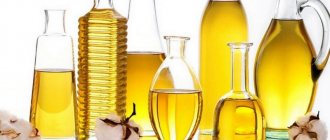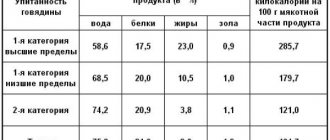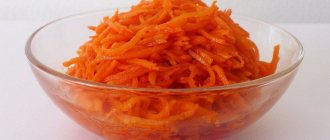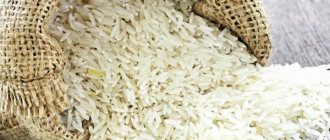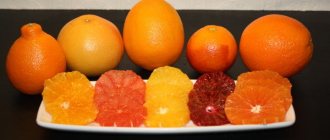Like other vegetables, bell peppers have a large number of useful elements in their chemical composition. Each of them is important for the proper functioning of the body as a whole and its individual systems in particular.
In this regard, a vegetable is one of the most nutritious foods, so it is useful in a person’s daily diet. And its low calorie content makes it an indispensable product in dietetics.
Chemical composition of the vegetable
Considering its composition, bell pepper can be called a unique vegetable:
| Vitamins, macro- and microelements | Main beneficial properties |
| Retinol | Good for vision, is a good antioxidant. |
| A nicotinic acid | Supports proper functioning of the heart and blood vessels, regulates cholesterol levels in the blood. |
| Ascorbic acid | Increases the body's defenses. |
| B vitamins | Regulate the functioning of the nervous system, have a beneficial effect on memory, and increase stress resistance. |
| Tocopherol | Promotes rejuvenation and stimulates tissue regeneration. |
| Phylloquinone | Regulates the process of blood clotting, promotes bone tissue restoration and participates in calcium metabolism. |
| Beta carotene | One of the most powerful antioxidants. Has a beneficial effect on the visual system and immunity. |
| Potassium | Removes excess salt, prevents the development of sclerosis. |
| Calcium | Plays an important role in the transmission of nerve impulses and is an integral part of bone tissue. |
| Phosphorus | Useful for the proper functioning of cells. |
| Magnesium | Involved in the distribution of calcium and participates in the formation of bone tissue, supports the functioning of the heart and blood vessels. |
| Sodium | Takes part in the transmission of nerve impulses. |
| Iron | It is an important substance for maintaining the level of hemoglobin in the blood and takes part in gas exchange processes taking place in cells. |
| Copper | Participates in the production of red blood cells, helps maintain stable functioning of the immune system. |
| Manganese | Regulates blood glucose levels. |
| Selenium | Good for the myocardium. |
| Zinc | Increases the body's protective functions and accelerates tissue regeneration. |
Bell pepper has several varieties; the actual presence of certain substances may differ from the list presented. This also changes the calorie content of the product slightly.
Health benefits of pepper
No product is a magic cure that will cure all diseases. But with regular use, you can count on a positive result, albeit small.
As for bell pepper, it has the following beneficial properties:
- reduces the risk of developing anemia;
- prevents the formation of cancer cells;
- improves eye health;
- has a positive effect on mood;
- helps strengthen the immune system;
- helps reduce weight;
- has a beneficial effect on the quality and growth of hair, the condition of the skin and nails;
- reduces the level of bad cholesterol in the blood;
- removes toxins from the lungs;
- improves memory and reduces absent-mindedness;
- has an antibacterial effect on the digestive system;
- has a beneficial effect on the body of a pregnant woman and the development of the fetus.
Eating it on a regular basis will help restore proper functioning of the body and prevent the development of pathologies. This vegetable, like most others, is recommended to be consumed raw, since when cooked it loses more nutrients.
The ability of bell pepper to resist anemia is due to the presence of iron in its chemical composition, and the formation of cancer cells due to powerful antioxidants. In addition, it contains another substance that also reduces the risk of developing tumors.
Vitamins of group B, as well as P (bioflavonoids) and PP (nicotinic acid) have a beneficial effect on the cardiovascular and nervous system, namely normalize sleep, strengthen memory, increase performance and help fight stress.
Benefits of each type
It is believed that red pepper is the most useful type. It contains the largest amount of antioxidants, and also contains lycopene and rutin. These substances prevent the penetration of carcinogens into cells, accelerate the process of tissue regeneration and promote rejuvenation.
The yellow fruit contains, among other things, xanthophyll, an antioxidant that is a derivative of carotene, which also prevents the degeneration of cells into malignant ones.
Green bell peppers are rich in chlorophyll , a substance that removes free radicals from the body. To get the most benefit from the vegetable, it is recommended to consume different types of fruits.
Calorie content of fresh vegetables
Bell pepper is a dietary product, with approximately 25 kcal per 100 g. This means that those losing weight don’t have to worry about eating it every day. Orange, yellow, red, green are the fruits of one bush, the color of which directly depends on the degree of ripeness.
The number of calories in one bell pepper depends on the color, so it is better for those losing weight to give preference to the low-calorie green pod. It is slightly bitter and contains virtually no sugar. Many people like to eat red and orange vegetables, but their calorie content is higher.
Ground pepper contains fewer calories and microelements than regular pepper.
- Per 100 g of red bell pepper there are 26.8 kcal: 1.27 g of protein, 0 g of fat and 5.4 g of carbohydrates. It is recommended to use it to prevent cancer, atherosclerosis and vascular diseases, and restore the digestive system. Due to the high content of fiber, pectin, and starch, red fruits are indispensable for people suffering from vitamin deficiency, anemia, and depression. The combination of vitamin E and ascorbic acid thins the blood and prevents the formation of blood clots. Daily consumption of red fruits cleanses the body of toxins and cholesterol, therefore, has a beneficial effect on a person’s figure and health.
- 100 g of yellow pepper contains 27.2 kcal, 1.31 g of protein, 0 g of fat, 5.28 g of carbohydrates, a large amount of carotene and ascorbic acid. The yellow fruit is rich in potassium, which means it is necessary for people with heart disease. It helps strengthen nails, bones, and the walls of blood vessels, improves hair structure, and helps in the production of endorphins. Due to the absence of sucrose in the pulp, the product is recommended for diabetics. Yellow pepper is rich in antioxidants, so it is an excellent assistant in the preservation and regeneration of skin cells.
- Green pepper contains 33.2 kcal: 1.4 g protein, 0 g fat, 6.7 g carbohydrates. The capsaicin content helps lower blood pressure, improves appetite and pancreatic secretion. It is in green fruits that the amount of substances that can prevent cancer is higher than in its colored counterparts. It contains fatty acids: omega-3, omega-6, oleic, palmitic, stearic and others, the combination of which rejuvenates skin cells and tones the body.
- Hot chili peppers contain minerals, vitamins, and capsaicin, the presence of which determines its hotness. The vegetable is dietary, contains 40 kcal: carbohydrates - 7.2 g, fats - 0.3 g, proteins - 1.3 g. Its moderate consumption improves intestinal function and the secretion of gastric juice, eliminates constipation and speeds up metabolism. Ideal for people struggling with excess weight. Eating hot peppers is good for allergies and bronchial asthma.
Possible side effects
Along with its positive properties, bell pepper can also have a negative effect on the human body. More precisely, it can be used by everyone, unless the attending physician prohibits it.
However, the amount should be limited for the following diagnosed diseases:
- gastritis with high acidity and stomach ulcers;
- hypertension in acute or chronic course;
- ischemia;
- impaired renal and liver function.
This is due to the fact that bell pepper contains the alkaloid capsaicin, which irritates the walls of the stomach, and the effect on blood pressure makes regular use impossible for hypertension at any stage of its course. It is also important that the vegetable contains essential oils that contribute to the development of an allergic reaction, which can result in individual intolerance.
Use during pregnancy
Many pregnant women are wary of most foods, fearing that it will negatively affect the development of the fetus. However, during this period you can eat bell pepper, but within reason, that is, do not overeat. The only recommendation is that this vegetable, like others, should be consumed in season. The rest of the time, there is a high probability of buying a product filled with harmful substances.
Nutritional value of sweet pepper
It is clear that raw red sweet pepper is a low-calorie, dietary vegetable. But what is the nutritional value of bell pepper remains to be figured out. This vegetable is characterized by a rich composition. It contains a lot of vitamins, microelements and other useful substances.
It is rich in vitamins A, K, B, C, E and P. If you compare peppers with currants or lemon, you can see that they contain much more vitamin C. In terms of vitamin A content, sweet peppers are not inferior to carrots. The product is not deprived of minerals either. So, it contains quite a lot of phosphorus, potassium, iodine, and calcium. There is also fluorine, manganese and sodium.
The nutritional value of bell pepper - bzhu (proteins/fats/carbohydrates) is given below:
- Carbohydrates contain 82%.
- Proteins about 15%.
- Fats make up only 3%.
Dietary fiber is also present in the pulp. They are about 5% of the body's daily needs. There is also water. About 3.5%.
Calories and nutritional value
Red, yellow and green peppers either have no differences at all in chemical composition and calorie content, or these differences are insignificant:
| Treatment | Calories (red/yellow/green) |
| Fresh (100 g) | 26,95/ 27,09/ 26,00 |
| Fresh (1 piece, weight approximately 200 g) | 53,9/ 54,18/ 52,00 |
| Marinated | On average 25 kcal per 100 g |
| Dried | On average 282 kcal per 100 g |
| Boiled | On average 28 kcal per 100 g |
Pickled
Pickled bell peppers are an excellent stand-alone snack that can be used as an addition to various dishes and as a component of a variety of salads. According to the general rules of pickling, a mandatory ingredient in brine is sugar, which not only acts as a preservative, but also softens the aggressive effect of vinegar. And in recipes for this vegetable, it is customary to use sunflower oil, which gives the dish a completed form, but further increases the energy value. As a rule, for 3 kg of fruits take 1 liter of water, 1 glass of vinegar and oil, 1 tbsp. l. salt and 4 tbsp. l. sugar and spices to taste. With this method of preparation, the calorie content of 100 grams of pickled bell pepper will be 62 kcal. But if you remove sunflower oil from the recipe, the total calorie content will drop to 27-30 kcal/100 g.
A similar preparation called “Traffic Light” looks unusually original and beautiful, containing fruits of three colors - red, yellow, green. In any case, in addition to excellent taste and attractive appearance, up to 80% of vitamins and other valuable elements are retained in pickled products. In addition, as a result of pickling, the beneficial properties of fresh vegetables are added to the benefits of bacteria and enzymes formed during the cooking process.
Important! Heat treatment of fruits containing lycopene significantly increases its absorption by the body. Therefore, the thermal effect, which negatively affects the quality of the vitamin composition and calorie content of bell pepper, at the same time significantly increases the beneficial effect of lycopene.
Reasonable consumption of such a snack before main meals can reduce the energy value of the daily diet by 150–200 kcal. This is due to the minimal calorie content of bell pepper and the product’s ability to quickly satisfy hunger, reducing the need for food.
BJU containing different types of pepper
The amount of proteins, fats and carbohydrates contained in bell peppers of different types is also not very different:
| (g/ 100 g product) | Red | Yellow | Green |
| Squirrels | 1,30 | 1,25 | 1,30 |
| Fats | 0,00 | 0,05 | 0,00 |
| Carbohydrates | 5,53 | 5,33 | 5,43 |
To calculate the BJU of one fruit, the figures presented in the table should be multiplied by 2, since on average it weighs 200 g.
What is the difference between the caloric content of red peppers and green or yellow ones?
The calorie content of the product also depends on its color. Thus, a yellow vegetable contains approximately 3 kcal more than a red fruit. Differences in caloric content are explained by different amounts of nutrients in the composition.
Green peppers are considered the lowest calorie type due to their minimal carbohydrate content.
For this reason, the unripe fruits of the plant have a slightly bitter taste. But yellow and red fruits lead in the amount of sugar in their composition, so they are valued for their energy value.
Also, vegetables of different degrees of maturity differ in the content of minerals, vitamins and other substances necessary for the normal functioning of the body. Green fruits are rich in capsaicin, a substance that stimulates appetite and improves the condition of the gastrointestinal tract. It is capsaicin that gives green peppers their characteristic bitter taste. The yellow vegetable contains a large amount of pectin, rutin and fiber, and the red vegetable contains vitamin C and beta-carotene.
A 100 g serving of green vegetables contains about 20 kcal, while yellow and red fruits contain 29, 5 and 27 kcal, respectively.
Therefore, people who are losing weight should give preference to green fruits due to their low sugar content. But in case of poor immunity, it is recommended to introduce a red vegetable into your diet, since it contains a large amount of vitamin C.
It is worth considering that the color of the plant’s fruits varies depending on their degree of ripeness, not the variety. So, on one plant, green peppers appear first, which over time change color to yellow, and later to red. Fruits of any degree of maturity are suitable for consumption.
Bell pepper and weight loss
Bell pepper has a low calorie content, so it is excellent for feeding people with diabetes, as well as people who adhere to a diet, including a strict low-carbohydrate diet. Despite the fact that it is a fairly light product, bell pepper gives the body energy that lasts for a long time, thereby suppressing appetite.
This vegetable perfectly removes waste and toxins. The bell pepper diet is aimed mainly at breaking down fat deposits and eliminating swelling. Those who adhered to such a nutrition system noted its high efficiency. However, there are a number of rules that must be followed to achieve the desired result.
General recommendations:
- When choosing fruits, you should pay attention to appearance. The tail of the pepper should be elastic and green, the surface should be free of dents, wrinkles and other damage, smooth, and the flesh should be elastic.
- The bell pepper diet can last a maximum of 2 weeks, after which you should switch to a more varied diet.
- A significant part of the menu is pepper. It is advisable to buy yellow or red - they are best suited for the diet, taking into account the nutritional value and calorie content.
- Harmful foods should be completely excluded from the diet. These include smoked foods, pickles, sweets, flour, spicy, fatty foods, alcohol, fast food, and carbonated sweet drinks. It is recommended to limit salt intake as much as possible.
- Additionally, it is recommended to include other vegetables and fruits in your diet. Only bananas, potatoes and grapes are undesirable for consumption, as they contain a lot of calories. In addition, you should eat mushrooms, lean meats and fish, dairy products and eggs.
- You need to drink at least 2 liters of water per day. Drink the first glass immediately after waking up. For drinks, you should give preference to green tea and rosehip decoction, but it is better to avoid coffee during the diet. Or at least limit its consumption to one cup every 2-3 days.
- No matter how paradoxical it may sound, it is also better to refuse active physical activity. However, you can find easier alternatives, such as walking in the evening before bed. This is due to the fact that the diet is not able to maintain energy balance during excessive physical activity.
- The last meal is taken 4 hours before bedtime.
Quitting the diet
The right output affects the result no less than the diet itself. If you immediately return to your usual diet, namely, start consuming unhealthy foods in large quantities, the lost weight will return.
During the first days, it is recommended to gradually include in the diet the foods that were prohibited. Smoked, sweet, salty and fatty foods can be consumed, but in minimal quantities.
It is better to stew, bake or boil dishes, and eat vegetables and fruits fresh and in large quantities. For sweets, give preference to marshmallows, marshmallows and marmalade. The diet should be balanced and rich in protein.
Benefits for hair, skin and nails
Best materials of the month
- Coronaviruses: SARS-CoV-2 (COVID-19)
- Antibiotics for the prevention and treatment of COVID-19: how effective are they?
- The most common "office" diseases
- Does vodka kill coronavirus?
- How to stay alive on our roads?
Everyone dreams of beautiful and healthy hair. But poor nutrition, poor environment and illness can cause thinning, hair loss, split ends, and dandruff. Sweet pepper improves blood circulation, which has a beneficial effect on the scalp and accelerates the growth of new hair. In addition, pepper contains many substances that help strengthen hair and nails.
The bright Bulgarian fruits contain huge reserves of vitamin C, which promotes the production of collagen in the body. The elasticity and freshness of the skin depends on this substance. Also, do not forget about the huge list of antioxidants, and they are known to be the worst enemies of wrinkles and early aging. The juice of green peppers and carrots will help clear your face of age spots. Bell peppers are a good source of vitamin E, which is essential for healthy skin. If you want to keep your skin fresh for a long time, and make your hair strong and shiny, then there should always be a place for fresh pepper in your diet.
Use in dietetics
Bell pepper, whose calorie content is very low, formed the basis of the nutrition system. The diet is relatively varied, although for some people it may seem complex and monotonous.
An example of a low-calorie daily menu based on bell peppers
It is quite possible to follow the diet below. It is designed for 2 weeks, although it can be shortened at your discretion. The main thing is not to break down. If this happens, you need to take a 10-day break and then resume.
Sample menu:
| Day | Meal plan |
| 1st | Prepare 500 g of bell pepper and the same amount of any other vegetables in the preferred way: stew, steam or grill. You can leave them all fresh or only part of them, and heat treat the rest. The resulting amount is divided into 5 equal meals. Eat throughout the day, taking breaks of 2 hours. At the same time, do not forget about water, decoctions and teas. |
| 2nd | The rules and quantity of products remain the same as for day 1, only instead of various vegetables, fruits are consumed along with pepper. |
| 3-1 and 4th | For each day, 300 g of bell pepper and fruit are calculated, which are divided into 3 meals. For breakfast, eat 100 g of pepper and fruit, 1 boiled egg and drink a cup of green tea. The next meal is lunch, and then dinner. In each of them eat 100 g of pepper and fruit. |
| 5th – 7th | For breakfast – a mug of green tea with lemon, lunch – 300 g of pepper, lunch – 200 g of lean meat, afternoon snack – 200 g of low-fat cottage cheese, dinner – a mug of kefir. |
| 8th | The diet of 1 day of the diet is repeated. |
| 9 — 10 | The diet of days 3 and 4 of the diet is repeated. |
| 11- 14 | The diet is repeated for 5, 6 and 7 days of the diet. |
If the condition worsens, a feeling of weakness and other unpleasant symptoms appear, it is better to abandon such a diet and return to a balanced diet.
Low-calorie recipes with bell peppers
The vegetable is a common ingredient in many low-calorie cooking dishes that will help get your body in shape.
You may be interested in:
Canned peppers without sterilization for the winter Preserving sweet peppers for the winter in this way will take a minimum of time and effort, since it is done without...Read more...
Cream soup
Cream soup based on fried peppers is a tender and tasty dish that satisfies your appetite and does not contribute to weight gain.
To prepare it you need to take:
- Broth (chicken) – 1 l.
- Sweet red pepper – 4 pcs.
- Cauliflower – 1 pc.
- Onions – 1 pc.
- Coarsely ground chili – ½ tsp.
- Paprika – 1 tsp. l.
- Garlic – 1-2 cloves.
- Vegetable oil – 1 tbsp. l.
- Thyme – 1 tsp. l.
- Cheese (goat) – 100 g.
- Spices - to taste.
Creamy bell pepper soup
Before you start frying the peppers, you need to wash them, cut them in half and remove the seeds. Vegetables are fried in hot oil for 10 minutes on the inside. Place the fried vegetables in an airtight container for 20 minutes, after which they must be peeled and cut into cubes.
Cauliflower, disassembled into inflorescences, is baked in the oven for half an hour at 200°. At this time, fry the diced onion until soft. Then chopped garlic, thyme and chili are added to it. Next, pepper, cabbage, paprika, broth, goat cheese and spices are added to the mixture. The soup is boiled for 10 minutes, after which it is brought in a blender to a creamy consistency.
Stuffed pepper
This dish is widely popular all over the world.
Ingredients:
- Pepper – 3 pcs.
- Rice – 150 g.
- Minced meat – 300 g.
- Onion – 1 pc.
- Garlic – 2 cloves.
- Paprika – 1 pinch.
- Spices - to taste.
Stuffed peppers
To prepare the filling, boil the rice and fry the finely chopped onion and garlic until soft. Minced meat and paprika are added to the onion and fried for 10 minutes. Then rice is added to the minced meat, and the resulting mixture is simmered in a frying pan for a few more minutes. Next, spices are added.
The peppers, from which the tops have been previously removed and the seeds removed, are stuffed with minced meat. The stuffed vegetables are laid out on a baking dish, at the bottom of which it is recommended to pour a little water. Peppers are baked for 15 minutes at a temperature of 220°.
You may be interested in:
Georgian bell pepper appetizer, tasty and simple Try an interesting version of Georgian pepper appetizer, prepared for the winter. Cooking strictly according to the recipe with...Read more...
Roasted Pepper Salad
A warm salad will not only satisfy your hunger, but will also delight you with its bright colors.
The salad includes:
- Sweet pepper – 3 pcs.
- Red onion – ½ pc.
- Parsley - to taste.
- Olive oil – 2 tbsp. l.
- Wine vinegar - ½ tbsp. l.
- Capers - 2 tbsp. l.
- Salt - to taste.
Baked pepper salad
The vegetable is peeled, cut into 6 pieces and lightly sprinkled with oil. Then it is laid out on a baking sheet and baked in the oven until soft. The finished pepper is cut into strips and mixed with chopped onions, capers and parsley. The salad is dressed with olive oil and vinegar.
Vegetable rolls
A simple and tasty dish, all you need to prepare is:
- 3 sweet peppers;
- 200 g cream cheese;
- 30 ml olive oil;
- spices.
Bell pepper rolls
Vegetables cut in half, without veins or seeds, are baked in the oven for 15 minutes at 200°.
Place the baked peppers in an airtight container for 10 minutes, after which the skins are removed. Cream cheese is mixed with the rest of the ingredients and spread on vegetables, cut into strips, after which they are rolled into rolls and secured with skewers.

